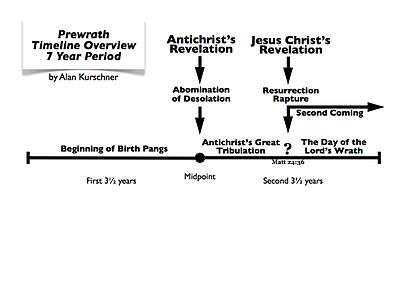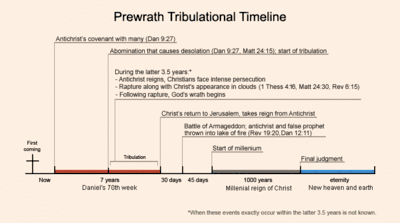Prewrath
The concept of a prewrath rapture is one of several premillennial views on the end times events among some evangelical Christians which states that Christians will be raptured at the end of a time called the Great Tribulation, before The Day of the Lord. The prewrath position emphasizes the biblical distinction between Satan's wrath in the Great Tribulation (which Christians have been promised) and the wrath of God, from which Christians have been promised deliverance.
| Christian eschatology |
|---|
|
Contrasting beliefs |
|
Key terms
|
| Christianity portal |
According to the prewrath perspective, the Great Tribulation begins three-and-a-half years after the Antichrist confirms "the covenant with many for one week" (Daniel 9:27), in the middle of "Daniel's 70th week." The 70th week is a reference to Daniel 9:24-27, where each day of the week corresponds to a year (for a total of seven years). After the first three-and-a-half years, the Antichrist will make himself known with as the abomination that causes desolation, and he will reign for three-and-a-half years (42 months or 1,260 days). The latter half of the three-and-a-half years is characterized by the Antichrist deceiving the world and persecuting the church.
Although the exact timing of the rapture is unknown, one of the key points to the prewrath view is that the rapture comes after the sixth seal is opened (Revelation 6:12), when the appearance of the moon is turned into blood. The tribulation of God's people will then be cut short (according to Jesus in Matthew 24:29–31, Mark 13:24–27) with the second coming of Christ and the rapture, and those who are left behind on Earth will face the trumpets and bowls of God's wrath (Rev 16:1); hence the term prewrath.[1][2]
God's wrath against the ungodly will follow for the remainder of the seven years, in what is known as the Day of the Lord.[3]
Origins
This view, like pretribulationism, midtribulationism, and posttribulationism, falls under the larger umbrella of premillennialism, and was formally named and publicized by Marvin Rosenthal in his book The Pre-Wrath Rapture of the Church, published by The Thomas Nelson in 1990,[4] at the prompting of his friend Robert Van Kampen I, who went on to write The Sign and The Rapture Question Answered: Plain & Simple.
Timeline


Much of the prewrath view is based on a linear, chronological interpretation of Jesus’ account of the end times in the Olivet Discourse. In contrast to the traditional Pre-Tribulation view, for example, the moon turning blood red occurs only once according to the prewrath perspective. Events following the rapture are based on face-value interpretations of the books of Revelation and Daniel.
- The "beginning of birth pains" start with wars, famines, and earthquakes around the world (Matthew 24:19). This duration is thought to cover the first three years and six months of Daniel's 70th week, which starts when the Antichrist confirms a seven-year "covenant with many" (Daniel 9:24).
- The Antichrist starts his reign with the “abomination of desolation” (Matthew 24:15) at the midpoint of the 70th week, putting an end to sacrifice and offering (Daniel 9:27). His reign, along with that of the false prophet (Revelation 13:11), lasts for 3.5 years.
- The Antichrist's rule begins the Great Tribulation, a worldwide distress unequaled by any across history (Matthew 24:21). At this time, the believers of God face persecution.
- During the latter half of the 3.5 years and prior to Jesus' return, the sun will be darkened, the moon will not give its light, and stars will fall from the sky (Joel 2:10, Matthew 24:29). In Revelation 6:12, this coincides with the opening of the sixth seal, when the sun turns black and the moon turns blood red.
- Jesus appears to all, coming in the clouds of heaven with power and great glory, and angels will rapture the Church (Matthew 24:30-31, 1 Thessalonians 4:16–17, 1 Corinthians 15:51–52). In Revelation, his appearance is signified by the people calling out to the mountains and rocks, "Fall on us, and hide us from the face of him that sitteth on the throne, and from the wrath of the Lamb" (Rev 6:12).
- God's wrath falls on the remaining unbelievers, called the "day of the Lord" (Joel 2:11). Since the Second Coming and the rapture of the Church occur immediately before the Day of the Lord, they happen before God's wrath: hence, the "prewrath rapture" of the Church. The 7th seal encompasses the wrath of the seven trumpets (Revelation 8:2); the seventh trumpet may represent the seven bowls of wrath, which complete the mystery of God (Revelation 11:15).
- Since the Antichrist's reign lasts for 42 months (or 3.5 years) according to Revelation 13:5, the Antichrist's rule ceases at the end of the 70th week.
- At the battle of Armageddon, the Antichrist and the false prophet are defeated and cast into the lake of fire. Since the time of the Antichrist is 1,290 days according to Daniel 12:11 (30 days longer than his 42-month reign), his end is then placed 30 days after Daniel's 70th week.
- 45 days after the destruction of the Antichrist, Christ's millennial reign is established. This is based on Daniel 12:11, which states, “Blessed is he that waiteth, and cometh to the thousand three hundred and five and thirty days.” The 45 days is derived from taking 1335 and subtracting 1260 days (42 months of Antichrist's reign) and 30 days (the end of the Antichrist), or 1335-(1260+30)=45.
Proposed confirmations
Prewrath adherents affirm that Scriptures from throughout the Old and New Testaments confirm this timing of the rapture:
- A side-to-side comparison of the wording of the sixth seal (Revelation 6:12–13) and the signs in Matthew 24:29 announcing the Second Coming of Jesus and the rapture of the Church indicate that they are the same event. Immediately after the sixth seal is opened in Revelation 6:12, the people of the earth, "said to the mountains and rocks, Fall on us, and hide us from the face of him that sitteth on the throne, and from the wrath of the Lamb" (the Lamb being Jesus Christ), indicating that they are viewing Jesus in the clouds. Since all of the people on earth (every slave and every free man) are crying out because of the wrath of God, this implies that all those on earth are unbelievers, and that the believers have already been raptured. Therefore, the rapture in Matthew 24:29–31 occurs after the sixth seal (Revelation 6:12-13), but before the seventh seal of God's wrath (Revelation 8:1). The church is said to be in heaven as the great multitude (Revelation 7:1 ff.), which has "come out of great tribulation" (Revelation 7:9–17).
- Throughout the Old Testament, the Day of the Lord is the term used for the time of God's final judgment and wrath upon the people of earth. According to Joel 2:31, "The sun shall be turned into darkness, and the moon into blood, before the great and the terrible day of the LORD come." This combination of the sun turning into darkness and the moon turning into blood is always used to symbolize the same event: the cosmic signs in heaven before the arrival of the Messiah. This places the Day of the Lord immediately after the arrival of Jesus Christ to rapture the Church (Joel 2:31, Revelation 6:12–13, Matthew 24:29).
- In 1 Thessalonians, Paul puts the Thessalonians' minds at ease that, while the members of this church were experiencing severe testing and tribulation, the Day of the Lord had not come upon them and they had not missed the Lord's return. Paul writes that those who are alive at the coming of the Lord (1 Thessalonians 4:15) will be caught up in the sky with Him at the rapture (1 Thessalonians 4:16–17). Then in Chapter 5, Paul writes that, "But of the times and the seasons, brethren, ye have no need that I write unto you. For yourselves know perfectly that the day of the Lord so cometh as a thief in the night" (1 Thessalonians 5:1-2); "But ye, brethren, are not in darkness, that that day should overtake you as a thief" (1 Thessalonians 5:4). According to prewrath, this passage clearly indicates that the coming of the Lord and the Day of the Lord are the same event. First, Jesus arrives in the sky at His Second Coming, at which time He raptures all Christian believers, then His judgment during the Day of the Lord falls upon those who have not believed on him.
- Prewrath may also distinguished from other premillennial rapture positions as to when, in relation to Daniel's 70th Week, the Second Coming and rapture take place. Pretrib places the rapture before the 70th Week. Midtrib places it at middle of the 70th Week. Posttrib places it at the end of the 70th Week. Prewrath places it at an unspecified time after the midpoint of the 70th Week, but before the end. This is justified, according to prewrath, because Jesus places His return (Matthew 24:30–31) after the abomination of desolation (Matthew 24:15), which occurs at the midpoint of the 70th Week (cf. Daniel 9:27, Daniel 11:31). Thus, if the Second Coming and rapture occur after the sixth seal, this event occurs after the midpoint but before the end (seventh trumpet).
Issues
The prewrath view contains some diversity with respect to:
- the chronology of seals, trumpets, and bowls (whether sequential, or chronological)
- the timing and nature of Christ's reign
- the fate of Israel during and after the tribulation
Differences on how specific events occur within the 70th week still fall under the framework of the prewrath timeline.
See also
References
- Showers, Renald E: The Pre-Wrath Rapture View, Kregel Academic & Professional (2001)
- Benware, Paul: Understanding End Times Prophecy: A Comprehensive Approach, Moody Publishers (2001)
- Rosenthal, Marv: "The Pre-Wrath Rapture of the Church: Is It Biblical?", Regular Baptist Press (1991)
- Rosenthal, Marv: "The Pre-Wrath Rapture of the Church: Is It Biblical?", Regular Baptist Press (1991)
Further reading
- Kurschner, Alan. Prewrath: A Very Short Introduction to the Great Tribulation, Rapture, and Day of the Lord. Pompton Lakes, NJ: Eschatos Publishing, 2014. ISBN 978-0-9853633-2-1.
- Van Kampen, Robert. The Rapture Question Answered: Plain and Simple. Grand Rapids, Michigan: Revell, 1997. ISBN 0-8007-5631-2.
- Nigro, H. L. Before God's Wrath: The Bible's Answer to the Timing of the Rapture, Revised and Expanded Edition. Milesburg, Pennsylvania: Strong Tower Publishing, 2004. ISBN 0-9704330-7-7.
- Bussard, Dave. Who Will Be Left Behind and When?. Lancaster, Pennsylvania: Strong Tower Publishing, 2002. ISBN 0-9704330-2-6.
- Cooper, Charles. God's Elect and the Great Tribulation: An Interpretation of Matthew 24:1–31 and Daniel 9. Milesburg, Pennsylvania: Strong Tower Publishing, 2008. ISBN 0-9815276-2-0. The first scholarly defense of the prewrath position.
- Fultz, Cameron. Prophecy's Architecture: How to Build an End-Times Doctrine. Milesburg, Pennsylvania: Strong Tower Publishing, 2005. ISBN 0-9704330-6-9.
- Rosenthal, Marvin, "The Pre-Wrath Rapture of the Church." Nashville: Thomas Nelson, 1990. ISBN 0-8407-3160-4.